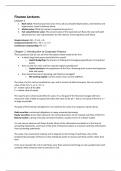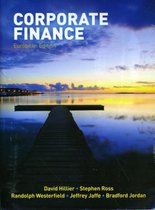Finance Lectures
Lecture 1
1. Book value: Historical purchase price minus all accumulated depreciation, amortization and
impairments. (used in balance sheet)
2. Market value: What the market is expected to pay for it.
3. Fair value/Intrinsic value: The present value of the expected cash flows the asset will yield
(discounted at a rate representative for the riskiness of earning these cash flows)
Simple interest: A(t) = P x (1 + rt)
Compound interest: P(t) = 𝑃0 𝑥 (1 + 𝑖)!
Continuous compounding: 𝑃0 𝑥 𝑒 "!
Chapter 1: Introduction to Corporate Finance
Three questions that we can ask from the balance sheet model of the firm:
• In which long-lived assets should the firm invest?
o Capital budgeting: the process of making and managing expenditures on long-lived
assets.
• How can the firm raise cash for required capital expenditures?
o Capital structure: the proportions of the firm’s financing from current and long-term
debt and equity.
• How should short-term operating cash flows be managed?
o Net working capital: current assets minus current liabilities.
The value of a firm can be visualised by a pie, and it consists of debt and equity. We can write the
value of the firm, V, as: V = D + E.
D = market value of the debt
E = market value of equity
The way the pie is sliced could affect its value. If so, the goal of the financial manager will be to
choose the ratio of debt to equity that makes the value of the pie – that is, the value of the firm, V –
as large as possible.
The goal of the financial management is to maximize the value of a company’s equity shares.
Debt securities: contractual obligations to repay corporate borrowing.
Equity securities: shares that represent non-contractual claims to the residual cash flow of the firm.
Money market: a group of loosely connected markets, usually in form of a dealer market.
It is not easy to observe cash flows directly. Much of the information we obtain is in the form of
accounting statements, and much of the work of financial analysis is to extract cash flow information
from accounting statements.
The value of an investment made by a firm depends on the timing of cash flows. One of the
fundamental principles of finance is that individuals prefer to receive cash flows earlier rather than
later.
Firms must consider the risk of cash flows since their amount and timing are not usually known with
certainty. Most investors have an aversion to risk.
,Companies can face upside, as well as downside risk, and the financial manager’s objective is to
identify the risk, measure it, then optimally manage it.
Two main ways a company can approach risk:
• Speculate and attempt to benefit by leaving the company exposed to future fluctuations in
prices or cash flows.
• Hedge against the risk and reduce its impact on the company’s future cash flows. If it hedges
too much; it will not benefit from future price or cash flow fluctuations. However, if it hedges
too little, it will be exposed to big shifts in cash flows or prices.
The goal of financial management is to make money or add value for the owners.
A clear definition is important because it leads to an objective basis for making and evaluating
financial decisions.
The financial manager acts in the shareholder’s best interests by making decisions that increase the
value of the company’s shares. The appropriate goal for the financial manager can thus be stated
quite easily:
The goal of financial management is to maximize the market value of the existing owners’ equity.
Corporate finance: the study of the relationship between business decisions and the value of the
shares in the business.
One major difficulty with the triple bottom line is the difficulty in accurately measuring, in monetary
terms, the effect a company has on society and the environment.
The financial manager best serves shareholders by making decisions that are valued by shareholders,
who in turn reflect the broader societal and environmental concerns of the general population.
Therefore, shareholder wealth maximization is consistent with the triple bottom line approach
(assuming shareholders have the same objectives and concerns as the general population.
Dealers are firms that make continuous price quotations for which they stand ready to buy and sell
short-term financial instruments for their inventory and at their own risk.
In the dealer market, the dealer bears the risk of holding the shares before he can find a
counterparty to buy them.
Bid-ask spread: the difference between the dealer’s buying- and selling price.
At the core of the money markets are the money market banks, government security dealers, and
many money brokers.
The financial markets can be classified further as the primary market and the secondary markets.
Corporations engage in two types of primary market sales of debt and equity: public offerings and
private placements.
A secondary market transaction involves one owner or creditor selling to another.
Although a corporation is only directly involved in a primary market transaction, the secondary
markets are still critical to large corporations. The reason is that investors are more willing to
,purchase securities in a primary market transaction when they know that those can be resold later if
desired.
Two types of secondary markets:
• Dealer
• Auction
Dealer markets in equities and long-term debt are called over-the-counter markets.
Auction markets differ from dealer markets in two ways:
• An auction market or exchange has a physical location.
• In a dealer market, most of the buying and selling is done by the dealer. The primary purpose
of an auction market, on the other hand, is to match those who wish to sell with those who
want to buy.
Chapter 2: Corporate Governance
Sole propietorship: eenmanszaak
- Cheapest business to form, no formal charter, articles or memoranda of association are
required. Very few government regulations must be satisfied for most industries.
- A sole proprietorship pays no corporate income taxes. All profits of the business are taxed as
individual income.
- The sole proprietorship has unlimited liability for business debts and obligations. No
distinction is made between personal and business assets. This means that if a sole
proprietorship owes money to creditors and cannot pay, the owner’s own possessions must
be used to pay off the firm’s debts.
- The life of the sole proprietorship is limited by the life of the owner of the firm.
- Because the only money invested in the firm is the proprietor’s, the cash that can be raised
by the sole proprietor is limited to the proprietor’s own personal wealth.
Partnership:
1) General partnerships
All partners agree to provide some fraction of the work and cash, and share the profits and losses of
the firm. Each partner is liable for the debts of the partnership. Partnership agreement specifies the
nature of the arrangement. Partnership agreement may be an oral agreement or a formal document
setting forth the understanding.
2) Limited partnerships
Permit the liability of some of the partners to be limited to the amount of cash each has contributed
to the partnership. Limited partnerships usually re
Chapter 3: Financial Statement Analysis
Statement of financial position/balance sheet: an accountant’s snapshot of a firm’s accounting
value on a particular date.
Assets = Liabilities + Shareholders’ equity
In principle, equity is what the shareholders would have remaining after the firm discharged its
obligations.
When analyzing a statement of financial position, the financial manager should be aware of three
concerns: liquidity, debt versus equity, and value versus cost.
, Liquidity: the ease and speed with which assets can be converted to cash.
Liquid assets frequently have lower rate of return than non-current assets; for example, cash
generates no investment income. To the extent a firm invests in liquid assets, it sacrifices an
opportunity to invest in more profitable investment vehicles.
Liabilities are debts and are frequently associated with nominally fixed cash burdens, called debt
service, that put the firm in default of a contract if they are not paid.
Market or fair value: the price at which willing buyers and sellers would trade the assets.
The Income Statement
Income statement/statement of profit and loss: statement that measures performance over a
specific period.
Several sections of the profit and loss statement:
• Operations section, reports the firm’s revenues and expenses from principal operations.
• Non-operating section, consists of all financing costs, such as interest expense. Usually, a
second section reports as a separate item the amount of taxes levied on income.
• Bottom line or net income.
When analyzing statement of profit and loss, the financial, manager should keep in mind non-cash
items, time and costs.
The economic value of assets is naturally connected to their future incremental cash flows. However,
cash flow does not appear in a statement of profit and loss.
Non-cash items: expenses against revenues but do not affect cash flow.
• Most important of these is depreciation.
In practice, the difference between cash flows and accounting income can be quite dramatic.
In the long run, all costs are variable. Accountants do not distinguish between variable costs and
fixed costs. Instead, accounting costs usually fit into a classification that distinguishes product costs
from period costs.
Product costs: the total production costs incurred during a period and are reported on the P&L
statement as cost of goods sold.
• Both variable and fixed costs are included.
Period costs: costs that are allocated to a time period, they are called selling, general and
administrative expenses.
Tax Rates
Your average tax rate is your tax bill divided by your taxable income.
Your marginal tax rate is the tax you would pay (in %) if you earned one more unit of currency. They
apply to the part of income in the indicated range only, not all income.
With a flat-rate tax the marginal tax rate is always the same as the average tax rate.






